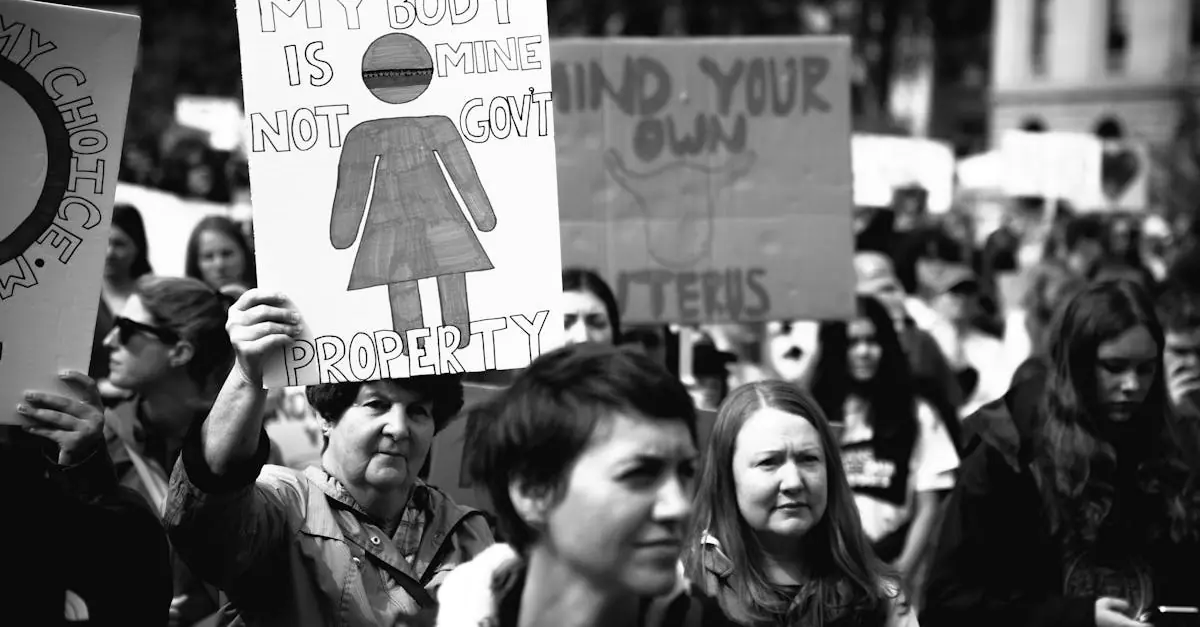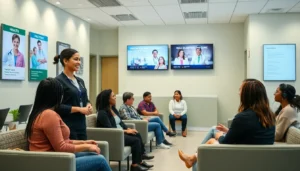Reproductive justice isn’t just a buzzword; it’s a movement that’s as vital as your morning coffee. It’s about ensuring everyone has the right to make decisions about their bodies, families, and futures without facing barriers or discrimination. Imagine a world where access to reproductive healthcare is as easy as ordering takeout—now that’s a dream worth fighting for!
Table of Contents
ToggleOverview Of Reproductive Justice
Reproductive justice encompasses the right to make autonomous decisions regarding one’s body, reproductive health, and family. It intertwines social justice and health equity, addressing systemic barriers that disproportionately affect marginalized communities. Advocates emphasize the importance of ensuring access to comprehensive reproductive healthcare, including contraception, prenatal care, and abortion services.
Policies shaped by reproductive justice aim to eliminate obstacles that restrict individuals’ rights. Examples include advocating for affordable healthcare, dismantling discriminatory laws, and combating misinformation. Each of these initiatives seeks to create an environment where everyone, regardless of socio-economic status or race, can exercise their reproductive choices freely.
Additionally, reproductive justice recognizes the broader implications of societal factors on individual choices. Economic stability, community support, and education significantly influence a person’s ability to access reproductive health services. As such, the movement extends beyond traditional reproductive rights, considering the intersection of various issues like poverty, racism, and gender inequality.
Data from various studies highlight the disparities in reproductive healthcare access. For instance, many low-income women and women of color face significant barriers to obtaining necessary services. Addressing these inequalities forms the backbone of the reproductive justice movement, striving for a future where all individuals possess the same opportunities to make informed choices about their reproductive health.
Through education, advocacy, and community empowerment, reproductive justice seeks to transform the current landscape, ensuring that individual autonomy and supported choices prevail.
Historical Context Of Reproductive Justice
Reproductive justice stems from a complex history deeply rooted in social movements focused on individual rights and equity. Its evolution reflects the intersections of race, gender, and class in advocating for comprehensive reproductive healthcare.
Roots In Women’s Rights Movement
The women’s rights movement laid the foundational principles for reproductive justice. In the 1960s and 1970s, activists fought for access to birth control and the right to abortion. Emerging leaders, such as Betty Friedan, called for women’s autonomy in decision-making about their bodies. This era emphasized the importance of reproductive health as part of broader gender equality. Activists increasingly recognized that socioeconomic factors also influenced access to such rights for marginalized women. By the 1990s, the dialogue began to expand, incorporating race and class into the conversation about reproductive choices.
Key Legal Milestones
Several significant legal milestones shaped the landscape of reproductive justice. In 1973, the landmark Supreme Court case Roe v. Wade established a woman’s right to privacy regarding abortion. This decision sparked debates and mobilizations around reproductive rights. The 1990s saw the rise of the women of color reproductive health movement, highlighting disparities in access to care. Furthermore, the Patient Protection and Affordable Care Act of 2010 aimed to increase healthcare access, including reproductive services. Tracking these milestones illustrates the ongoing struggle for equitable reproductive rights, pointing to the need for continuous advocacy and policy reform.
Core Principles Of Reproductive Justice
Reproductive justice comprises several core principles that ensure individuals can make informed decisions about their reproductive lives.
The Right To Have Children
The right to have children ensures individuals possess the freedom to start a family when they choose. Access to affordable healthcare, including prenatal and maternity care, forms a crucial part of this right. Marginalized communities face systemic barriers that limit their ability to conceive and raise children, often due to economic disparities. Policies promoting this right must address these inequities while securing access to fertility treatments and supportive resources. Support systems that allow individuals to pursue parenting contribute significantly to creating an equitable environment.
The Right To Not Have Children
Individuals possess the right to not have children, a principle essential to reproductive justice. Access to contraception serves as a fundamental aspect of this right, enabling choices about family planning. Many marginalized individuals encounter obstacles in obtaining birth control due to costs or lack of availability. Removing these barriers empowers individuals to make informed decisions about reproduction. Comprehensive sex education also plays a vital role in informing people about their options. Advocating for policies that ensure access to abortion services further strengthens this essential right.
The Right To Parent In Safe Environments
The right to parent in safe environments emphasizes the importance of family stability. Safe neighborhoods, affordable housing, and access to quality education create optimal conditions for raising children. When systemic inequalities persist, marginalized families struggle to provide secure environments for their children. Supportive community networks and resources enhance parenting experiences and create a nurturing atmosphere. Legislative measures protecting families from discrimination and violence also significantly contribute to family safety. Advocacy efforts should focus on fostering environments that empower all parents.
Current Challenges In Reproductive Justice
Reproductive justice faces significant challenges that hinder individuals’ rights. Legislative actions and socioeconomic factors contribute to ongoing disparities in access to reproductive healthcare.
Legislative Barriers
Legislative barriers create significant obstacles for people seeking reproductive health services. Many states impose restrictive laws, including waiting periods and mandatory counseling, which can delay access to care. Recent data shows that 28 states have enacted laws limiting abortion access, affecting millions. Discriminatory policies often target marginalized communities, making it harder for them to obtain necessary services. Legal restrictions also create a climate of fear surrounding reproductive choices. Advocacy groups continue to battle these laws through litigation and lobbying efforts. Ongoing political tensions highlight the need for vigilant monitoring and reform.
Socioeconomic Factors
Socioeconomic factors profoundly impact reproductive justice. Individuals with lower incomes often face challenges in accessing quality healthcare. Statistics reveal that low-income women experience higher rates of unintended pregnancies, further complicating their reproductive choices. Limited access to education also contributes to disparities in understanding available options. Community support and resources can significantly affect a person’s ability to make informed decisions. Systemic racism exacerbates these socioeconomic disadvantages, leading to even greater challenges for women of color. Addressing these factors is crucial for achieving equitable reproductive health outcomes.
Advocacy And Activism In Reproductive Justice
Advocacy and activism in reproductive justice encompass diverse strategies aimed at ensuring equitable access to reproductive healthcare. Grassroots movements play a pivotal role in mobilizing communities and fostering awareness.
Grassroots Movements
Grassroots movements often emerge from within affected communities to challenge injustices. These activists prioritize local issues, addressing barriers to reproductive healthcare access for marginalized groups. They organize events, educational workshops, and campaigns to amplify community voices and raise awareness. Connecting individuals and families to resources strengthens support networks. Mobilization efforts include rallies and social media campaigns, increasing visibility around reproductive rights issues. As community-driven initiatives, these movements foster solidarity among participants, creating a foundation for long-term change.
Role Of Nonprofit Organizations
Nonprofit organizations significantly impact reproductive justice by offering vital services and advocacy. These entities often provide education on reproductive health options, such as contraception and abortion services. Establishing partnerships with local communities enhances their outreach efforts. Legal assistance, funding, and comprehensive healthcare services frequently represent key offerings, ensuring access for those in need. Advocacy efforts frequently focus on legislative reform, addressing policy changes that restrict reproductive rights. Many organizations also tackle systemic issues, including poverty and racism, integrating them into their advocacy strategies. Collectively, these actions contribute to an evolving landscape of reproductive justice.
Reproductive justice is more than a movement; it’s a call for systemic change that empowers individuals to make informed choices about their bodies and families. Advocates are working tirelessly to dismantle barriers and create a society where everyone can access comprehensive reproductive healthcare without discrimination.
As the fight continues against restrictive laws and socioeconomic disparities, the principles of reproductive justice remain crucial. By addressing the interconnected issues of race, gender, and economic stability, the movement aims to ensure that every person has the autonomy to shape their reproductive lives.
Collective action and grassroots efforts are essential in this ongoing struggle, highlighting the need for community support and advocacy. The vision for a future where reproductive rights are universally respected and accessible is within reach, driven by the commitment to justice and equity for all.



